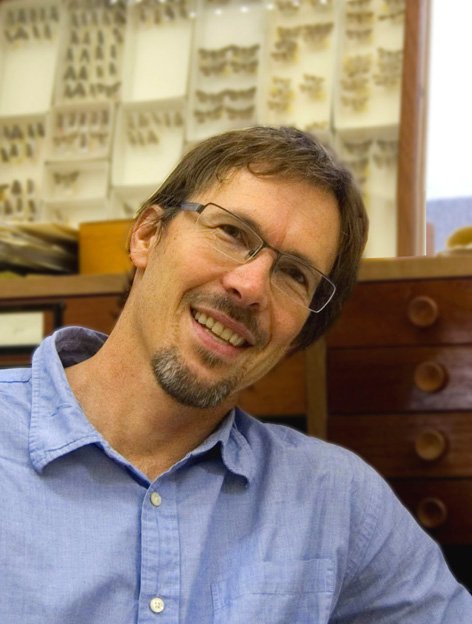Expedition to Malaita: The secret world of insects and snails in the remote forests of the Solomon Islands
Abundant varieties of moths, snails and insects lie awaiting discovery in the beautiful tropical forests of Malaita in the Solomon Islands. Recently Paul Flemons, Dr Andrew Mitchell and Dr Frank Köhler embarked on the AM expedition to work with the local community to collect and describe the islands smaller fauna.

A dwelling in the mountains of Malaita, Solomon Islands.
Image: Tim Flannery© Australian Museum
On Thursday the 11th of April three AM scientists prepared to make the long and arduous journey to the unique island of Malaita, in the Solomon Islands. After several plane trips and following a final gruelling trek through treacherous tropical terrain, the team reached a region of unique biological and cultural significance. At the end of the eight-hour climb they were greeted by the local Kwaio community and kitted out with the obligatory attire of a single large banana leaf.

Chief Esau in the forests of Malaita, Solomon Islands.
Image: Tyrone Lavery© Australian Museum
Paul Flemons, Expedition Lead and Coordinator, understands it is a rare opportunity to be involved in such remote community-lead conservation, expecting the trip to be as much as a cultural experience as it is a scientific survey. Along with project coordination, Paul will be collecting beetles on Dr Chris Reid’s behalf (an entomologist at the AM). Paul, experienced in field work in far off places, is still understandably apprehensive to be working in an area lacking in most first world comforts!

Paul Flemons, Expedition Lead and Coordinator.
Image: Stuart Humphreys© Australian Museum
Expedition members are enthused to work with local communities to uncover the biodiversity of the area. ‘For moths, the Solomons is almost unchartered territory’ reveals Dr Mitchell, who hopes the expedition will serve to develop a much-needed faunal baseline. In fact, the vast majority of what is currently known about Solomon Islands moth fauna was gathered in a single expedition to Rennel Island in 1954 by the British Museum. The AMs own collections of the region are also scant, consisting of a handful of specimen-containing drawers. Following the expedition, Dr Mitchell anticipates doubling the specimens in the collection by cataloging as many moths as possible from several Kwaio community reserves.

Dr Andrew Mitchell, Senior Research Scientist Entomology.
Image: Australian Museum© Australian Museum
The recorded knowledge of gastropod fauna of the region are in a similar state, with little known reference collection. Dr Köhler, Senior Research Scientist at the AM, is a gastropod expert and is particularly interested in land snails. ‘Land snails often have a small-scale distribution, and are commonly relatively endemic, so they are good indicators for conservation and biodiversity’ he says. Apart from collecting and describing novel species he hopes the data will provide biogeographic information. In particular, he anticipates the data may reveal how the local fauna connects to Australian fauna, and eventually he aims to reconstruct a history of how these organisms dispersed over large areas.

Dr Andrew Köhler, Senior Research Scientist Malacology.
Image: Australian Museum© Australian Museum
Dr Köhler also hopes information from the expedition will assist the AM and local conservationists to understand if the chosen Kwaio community reserves are functional in protecting biodiversity. For example, do the reserves contain a significant proportion of biodiversity and does their location make sense when trying to maximise the species in an area?
Due to its remote location this expedition does not come without considerable challenges in specimen collection. Snails can be onerous to survey as one must collect them manually, meticulously searching for them in leaf litter and on trees. Nocturnal moths on the other hand, can be collected with a strong light at night. But this moth attracting light comes with its own difficulties, as it needs to be charged each night. In a village with no mains power the team will be reliant on a wind generator and helpful locals.

Lush scenery of Malaita, Solomon Islands.
Image: Rebecca Johnson© Australian Museum
Insect and gastropod preservation may also prove problematic as the expedition is taking place in the wet season, and this tropical humid environment may hasten specimen decay. And last, but not least, once back at the museum there is the extensive job ahead describing each species, made all the more problematic due to the limited collection in which to cross reference. The scientists will use both microscopic anatomical examination (for example on reproductive organs), as well as molecular analyses, to determine where a specimen lies in the phylogenetic tree.

Southern Pink Underwing Moth, Phyllodes imperialis smithers
Image: Stuart Humphries© Australian Museum
These challenges do little to dampen the enthusiasm of AM expedition members. Dr Köhler is looking forward to working in close contact with the local Kwaio people, to understand how they interact with the environment they live in as well as to exchange knowledge on conservation efforts in the region. And for Dr Mitchell, the holy grail in moths is to find the large and magnificent Phyllodes imperialis. This moth has beautifully camouflaged leaf shaped forewings, and hindwings with a startling pink spot. Described in the area several decades ago, Dr Mitchell wishes to discover if it is the same species as found on the east coast of Australia.
With the team due to return from the expedition in late April, watch this space to discover the trials and tribulations of their journey!
Emma Flannery
(Communications Administrator – Solomon Islands Conservation Alliance)

